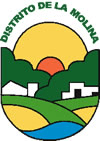La Molina District
| La Molina | ||
|---|---|---|
| District | ||
|
District sign at La Molina Avenue | ||
| ||
|
Location of La Molina in Lima Province | ||
| Coordinates: 12°4′40″S 76°54′40″W / 12.07778°S 76.91111°WCoordinates: 12°4′40″S 76°54′40″W / 12.07778°S 76.91111°W | ||
| Country |
| |
| Region | Lima | |
| Province | Lima | |
| Founded | February 6, 1962 | |
| Capital | La Molina | |
| Government | ||
| • Mayor | Juan Carlos Zurek | |
| Area | ||
| • Total | 65.75 km2 (25.39 sq mi) | |
| Elevation | 241 m (791 ft) | |
| Population (2005 census) | ||
| • Total | 124,468 | |
| • Density | 1,900/km2 (4,900/sq mi) | |
| Time zone | PET (UTC-5) | |
| UBIGEO | 150114 | |
| Website | munimolina.gob.pe | |
La Molina is a district of the Lima Province in Peru, and one of the upscale districts that comprise the city of Lima. Officially established as a district on February 6, 1962, the current mayor (alcalde) of La Molina is Juan Carlos Zurek. The district's postal code is 12.
Geography
The district has a total land area of 65.75 km². Its administrative centre is located 241 metres above sea level.
La Molina is located between 12° 00' 07" S, 76° 57' 00" and 76° 51' 00" W.
Boundaries
- North: Ate
- East: Cieneguilla and Pachacamac
- South: Villa María del Triunfo and San Juan de Miraflores
- West: Santiago de Surco
Demographics
According to the 2005 census by the INEI, the district has 124,468 inhabitants, a population density of 1,893 persons/km² and 33,646 households. Annual median income varies greatly.
History
Name
There are two possible origins, both referring to the owners of the estates located in the area in the Peruvian Republican era.
- Captain Nicolás Flores de Molina, owner of La Molina estate.
- Melchor Malo de Molina, Marquis de Monterrico, owner of Monterrico Grande estate.
Creation
In the years before its creation, the estates located in the geographic area of the district (Granados, Melgarejo, La Rinconada, Camacho and La Molina) had been already sold (or expropriated by the Juan Velasco Alvarado administration) and divided, giving origin to smaller yet large properties. Soon, due to the quiet and beautiful surroundings, owning country houses in La Molina became a trend for high class people. This resulted in the populating of the first neighbours, individuals with high incomes. Finally, on February 6, 1962, La Molina district was officially created by Act No. 13981 during the Manuel Prado Ugarteche government.
Philanthropy
Some members of the community are active members in "Un techo para mi pais" which helps people in need build houses. TECHO
Urban distribution
La Molina district is divided into middle, middle-high and upper class suburbs.
Upper class suburbs
La Molina is best known for the large and luxurious houses that give shape to expensive properties located in suburbs like La Planicie, Rinconada, Las Lagunas, Camacho, Residential Monterrico, La Molina Vieja, Alameda de la Molina Vieja, Los Sirius, Corregidor, El Remanso and Huertos de La Molina. Numerous Peruvian celebrities, leading business people and political figures live in these suburbs. Due to their relative safety, calm and low population density, these suburbs are highly valued real estate. Furthermore, some of the most exclusive Peruvian social clubs are located in the area: Rinconada Country Club, La Planicie Country Club and Hebraica Club.
Middle and upper middle class suburbs
Santa Felicia, Santa Raquel, Covima, Santa Patricia, La Ensenada, La Capilla, Las Acacias, Los Ingenieros, Pablo Bonner, Pablo Cánepa, La Fontana and Farwest compose the middle and middle-high class area in the district. They compose the largest part of the district. Some suburbs (Santa Patricia, Santa Felicia, Santa Raquel and Covima) used to belong to the neighbouring district of Ate, but they were won over by La Molina. The process was led by the desire of the residents.
MUSA is a special case. It started as a human settlement, but after a great effort and the help of La Molina Government, they achieved the awarding of their properties.
Urban development
La Molina faces an accessibility problem because the Javier Prado and Raúl Ferrero avenues serve as the only roads that connect this district with the rest of the city of Lima, and thus become overloaded during peak hours. Modern enterprise buildings, shopping malls and private universities are found in La Molina. An intense urbanizing process has turned La Molina into an example of development and progress for the country.
On Av. Raul Ferrero is located the principal mall of the district, called "Molina Plaza", one of the most important commercial centres of Lima. It was inaugurated in 2005 and belongs to the Brescia Group. This mall helped the commercial evolution of this important avenue where nowadays are found premium restaurants, bars and boutiques.
In education, many of the first class private schools in Lima are located in La Molina, including Newton College, Colegio Waldorf-Lima, Frankin D. Roosevelt School, Peruvian North American Abraham Lincoln School, Colegio Villa María, Colegio La Recoleta, Colegio Alpamayo, Colegio Antonio Raimondi, Reina de los Ángeles School, Villa Caritas, San Pedro School, Peruvian-German School Reina del Mundo, Colegio Domingo Faustino Sarmiento, Lord Byron School, Colegio Altair, La Molina Christian Schools, etc. Several universities are located in La Molina as well, including Universidad Nacional Agraria La Molina, Universidad San Ignacio de Loyola, Universidad Femenina del Sagrado Corazón (UNIFE) and Universidad de San Martín de Porres.
External links
- Portal de la Municipalidad de La Molina - La Molina Municipal Council official portal

